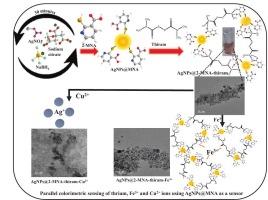Synthesis of 2-mercaptonicotinic acid capped silver nanoparticles for sensing of thiram and their nanoaggregates for detection of Fe3+ and Cu2+ ions
Q1 Environmental Science
Environmental Nanotechnology, Monitoring and Management
Pub Date : 2025-09-14
DOI:10.1016/j.enmm.2025.101100
引用次数: 0
Abstract
Excessive use of pesticides and heavy metals can pose serious risks to human health and ecological balance. These pollutants persist in soil and water and bioaccumulate in organisms, leading to metabolic disruption and environmental damage. In this situation, simple, quick and inexpensive sensing platforms are essentially required to assay both pesticide residues and metal ions in environmental samples at the same time. This work represents the development of a dual-responsive colorimetric sensing probe for the detection of thiram using silver nanoparticles (AgNPs) modified with 2-mercapto-nicotinic acid (2-MNA) (AgNPs@2-MNA) and further AgNPs@2-MNA-thriam nanoaggregates were used for parallel detection Fe3+ and Cu2+ ion, respectively. The characteristic surface plasmon resonance (SPR) of AgNPs@2-MNA was remarkably shifted upon the addition of thiram, thereby forming AgNPs@2-MNA-thiram nanoaggregates, which was further used for the detection of Fe3+ and Cu2+ ions via complex-assisted sensing mechanism. The assay came out with good linear ranges and the lower limits of detection as calculated for thiram, Fe3+ and Cu2+ are 0.474, 0.411 and 0.487 µM, respectively. This colorimetric assay was successfully validated for the detection of thiram and two metal ions (Fe3+ and Cu2+) in real environmental samples, highlighting its potential for field-deployable environmental monitoring.

2-巯基烟酸包覆银纳米粒子的合成及其纳米聚集体检测Fe3+和Cu2+离子
过度使用农药和重金属会对人类健康和生态平衡造成严重威胁。这些污染物持续存在于土壤和水中,并在生物体中生物积累,导致代谢紊乱和环境破坏。在这种情况下,需要简单、快速和廉价的传感平台来同时检测环境样品中的农药残留和金属离子。这项工作代表了一种双响应比色传感探针的发展,该探针使用2-巯基烟酸(2-MNA)修饰的银纳米粒子(AgNPs) (AgNPs@2-MNA)和AgNPs@2-MNA-thriam纳米聚合体分别用于平行检测Fe3+和Cu2+离子。随着thiram的加入,AgNPs@2-MNA的特征表面等离子体共振(SPR)发生了显著的变化,从而形成AgNPs@2-MNA-thiram纳米聚集体,并通过配合物辅助传感机制进一步用于Fe3+和Cu2+离子的检测。结果表明,该方法具有良好的线性范围,铁、铁、铜的检出下限分别为0.474、0.411和0.487µM。该比色法已成功用于检测实际环境样品中的铁和两种金属离子(Fe3+和Cu2+),突出了其在现场部署环境监测方面的潜力。
本文章由计算机程序翻译,如有差异,请以英文原文为准。
求助全文
约1分钟内获得全文
求助全文
来源期刊

Environmental Nanotechnology, Monitoring and Management
Environmental Science-Water Science and Technology
CiteScore
13.00
自引率
0.00%
发文量
132
审稿时长
48 days
期刊介绍:
Environmental Nanotechnology, Monitoring and Management is a journal devoted to the publication of peer reviewed original research on environmental nanotechnologies, monitoring studies and management for water, soil , waste and human health samples. Critical review articles, short communications and scientific policy briefs are also welcome. The journal will include all environmental matrices except air. Nanomaterials were suggested as efficient cost-effective and environmental friendly alternative to existing treatment materials, from the standpoints of both resource conservation and environmental remediation. The journal aims to receive papers in the field of nanotechnology covering; Developments of new nanosorbents for: •Groundwater, drinking water and wastewater treatment •Remediation of contaminated sites •Assessment of novel nanotechnologies including sustainability and life cycle implications Monitoring and Management papers should cover the fields of: •Novel analytical methods applied to environmental and health samples •Fate and transport of pollutants in the environment •Case studies covering environmental monitoring and public health •Water and soil prevention and legislation •Industrial and hazardous waste- legislation, characterisation, management practices, minimization, treatment and disposal •Environmental management and remediation
 求助内容:
求助内容: 应助结果提醒方式:
应助结果提醒方式:


